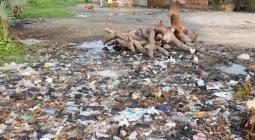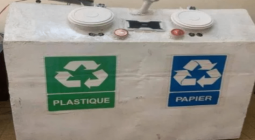‘I’ve seen solid waste float by’: Surrey riverside residents try to Stop the Poo
The sewage treatment works at Horley seem to be crumbling, much like owner Thames Water itself
The brochure boasts of a family-friendly community located in tranquil green space within easy reach of high-speed links to London.
However, the residents of a new development of 1,500 homes in Horley, Surrey, have recently set up a WhatsApp group, whose title illustrates a less attractive feature of the community: Stop the Poo.
The group was created in desperation as residents sought answers from Thames Water after a winter of storms that exposed the terrible state of the sewage treatment works on the River Mole at Horley, which abuts the new development.
“When it rains, not only does raw sewage pour into the river via the storm overflows, but the sewage overtops the storm tanks and flows on to the public footpath,” said Keith Barlow, the chair of the Westvale Park residents’ association. “Sewage floods over the footpath and into the recreation area where people walk with their children and dogs. I have seen solid waste floating past through the perimeter fence.”
The situation in Horley is in some respects a metaphor for what is taking place at Thames Water itself.
The biggest privatised water company in England is straining financially with debts of £14.7bn, struggling to shore up infrastructure crumbling from decades of underinvestment, and fighting for its reputation as investigators from Ofwat prepare to publish the findings of an investigation into potentially illegal sewage discharges from scores of its treatment plants, including Horley. The government is drawing up an emergency plan in case of the company’s insolvency, but Thames is seeking a shareholder bailout to avoid a takeover.
As Barlow and others have pursued Thames Water over the sewage pollution taking place in their locality, the layers of what should be a functioning public utility have been stripped away to reveal the fragility of the whole corporate core, no more so than when he was invited for a tour of the Horley works by Thames.
“What we saw was horrific,” said Barlow. “It looked like a crumbling wreck from the 1950s. I didn’t expect it to be quite so bad. It’s not a staffed facility, it is all run on telemetry, and as we went around we saw sewage sludge pouring out of the side of a copper-coloured storage tank where it was perforated.”
When Barlow asked what would be done to stop the pollution, officials pointed out sandbags lined up along the inside perimeter of the treatment works. But it was clear the sewage was able to breach the makeshift barriers.
Over the following weeks of the winter, in an attempt to stop the flooding, Thames threw more sandbags on to the pile but still the sewage seeped through on to the footpath and tests of a ditch nearby revealed high levels of E coli.
Multimillion-pound penalties could be imposed on Thames as a sanction once Ofwat completes its investigation into thousands of sewage treatment works across the country. This will only add to the pressure on the struggling company as it seeks a shareholder injection of £2.5bn to avoid being taken into administration.
“It doesn’t surprise me that Thames are in such a poor state today,” said Theo Thomas, of the campaign group London Waterkeeper, who has spent nearly 10 years pressuring Thames Water to come clean about the river pollution from its sewage discharges.
It took more than five years, and the threat of a judicial review from Thomas, for the company to agree to publish real-time data on its sewage discharges via storm overflows into the Thames and its tributary rivers in 2023.
But in the past six months, the company has revealed the existence of a further 142 storm overflows it had not previously mentioned.
“There is still a lot we don’t know about Thames Water and its assets,” said Thomas. “They are still a long way from being fully transparent. A lack of accountability and transparency has put Thames Water in this difficult position, with blame shared by the regulators and government.”
A lack of transparency was exposed last year when Judge Christine Laing KC criticised Thames Water for deliberately misleading the Environment Agency as she fined it £3.34m for devastating pollution of the River Mole near Crawley.
Millions of tonnes of raw sewage was dumped into the river, killing thousands of fish, when a pump at Crawley sewage treatment works diverted sewage to its storm tank for 21 hours during dry weather.
Cover photo: Sandbags lined up along the inside perimeter of the Horley treatment works in an attempt to stop sewage spilling on to the footpath. Photograph: Keith Barlow






